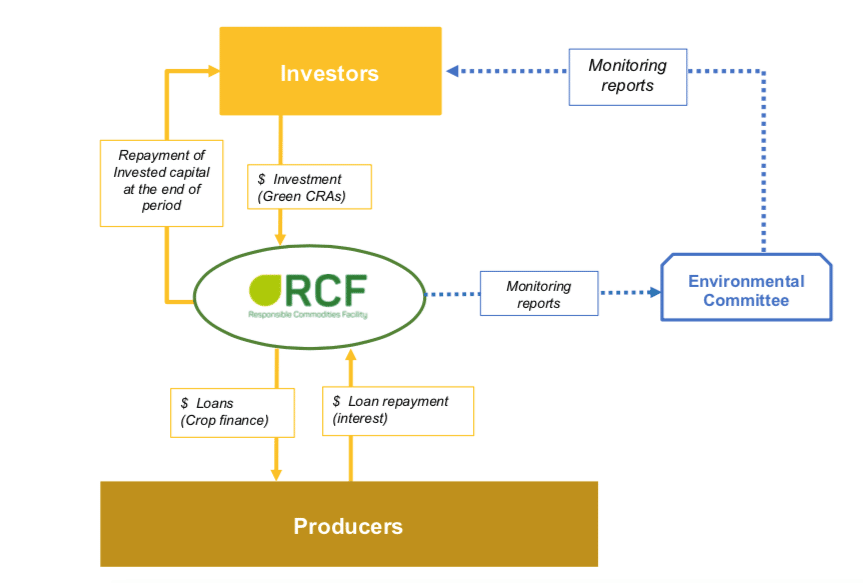| Title | Responsible Commodities Facility – Cerrado Programme 1 |
| Country/Location | Brazil |
| Size | $11 million |
| Revenue Model | Repayments from Brazilian farmers advanced low interest loans to produce sustainable soy crops |
| Private Investment/Finance Structure | Four-year green bonds (green agribusiness receivables certificates – ‘CRAs’) |
| Public/Philanthropic Investment | $150,000 seed funding for the development of the Responsible Commodities Facility |
| Env/Social Impact | Production of sustainable soy, carbon storage, conservation of native vegetation in Brazil’s Cerrado Biome |
Summary
The Responsible Commodities Facility provides financial incentives to produce soy in existing cleared and degraded lands in order to discourage further expansion of agricultural land in the Brazilian Cerrado. An $11m pilot fund has been launched with four-year green bonds bought by Tesco, Sainsburys and Waitrose, and the proceeds are used for low-interest loans to nine large farming groups.
Growing demand for soy is leading to the deforestation of large tracts of vegetation in the Cerrado Biome in Brazil, the vast tropical savannah that covers about 20% of the country, with 85% of this happening legally under Brazil’s Forest Code. Deforestation in the Cerrado has increased green house gas emissions and decreased biodiversity, becoming one of the biggest environmental challenges facing the country.

Pedro Moura Costa, Co-founder and CEO of Sustainable Investment Management (SIM) and Co-founder and Director of BVRio Environmental Exchange
However, Brazil’s soy farming sector can expand without clearing any more natural vegetation in the Cerrado, because the amount of cleared land available for soy cultivation in the area is already three times what the industry needs, according to Pedro Moura Costa, co-founder and CEO of Sustainable Investment Management (SIM) and co-founder and director of BVRio Environmental Exchange, a Brazilian NGO that creates market mechanisms to solve environmental problems.
Call to action
The problem of deforestation in the Cerrado became so severe that over 60 Brazilian civil society organisations, including BVRio, signed the Cerrado Manifesto in 2017, calling for immediate action from the Brazilian government, soy buyers, traders and investors to protect the Brazilian Cerrado.
The same year, CEOs from around 23 global companies, including Tesco, Sainsburys, Waitrose, Ikea, Unilever, Nestle, McDonald’s and Walmart, signed a Statement of Support for the Cerrado Manifesto, committing to support the objectives of the Cerrado Manifesto and to halt deforestation in the Cerrado. Subsequently, around 50 more companies signed the Statement of Support.
BVRio signed both the manifesto and the Statement of Support, but the intent of both still had to be put into action. “The problem was that we needed a mechanism to provide incentives to soy farmers so that they opt to use already cleared land, instead of expanding into the Cerrado,” says Moura Costa.
Inception
As a result, Moura Costa created The Responsible Commodities Facility (RCF), an initiative to promote the production and trading of responsible soy in Brazil by creating a financially sustainable vehicle to provide financial incentives to farmers. The development of the RCF received $150,000 in seed funding from Good Energies Foundation and a group of Forest Positive Coalition companies.
“We were working on the RCF in 2018 and 2019 and we were ready to launch our first $300 million debt fund at the end of 2019. We even had an announcement at the London Stock Exchange,” says Moura Costa. However, the arrival of the Covid-19 pandemic soon afterwards meant that the launch was no longer viable, and the idea of the Fund was put on ice.
At the beginning of 2021, however, a small subgroup of those companies that had signed the Statement of Support came together to look at various financial instruments, including the RCF, which could help to deliver the objectives of the group. The decision was made to relaunch the RCF’s debt fund with a small pilot project to demonstrate the concept, managed by SIM, which could be scaled in the years to come.
The result was the Cerrado Programme 1, which was announced in August 2022. Under the programme, Tesco, Sainsburys and Waitrose, which were all active members of the subgroup, bought $11 million of four-year green bonds (green agribusiness receivables certificates), issued and registered on the Vienna Stock Exchange, to capitalise a debt Fund. All three participating supermarkets will receive a coupon, while the pilot Fund, in turn, has advanced low interest rate loans to large soy farmers in the Cerrado that meet its eligibility criteria.
Eligibility of farmers
Under the pilot Fund’s structure, all the farmers have been pre-selected so 100% of the capital raised by the bonds has already been disbursed to 36 farms of nine large farming groups. Each farming group received on average about $1 million from the Fund.
To be eligible for the Programme, farmers must commit to zero deforestation of any native vegetation in their farms. Additionally, they must be in full compliance with Brazil’s Forest Code, have the right to use the land, and demonstrate that they do not contravene any environmental or legal requirements. The cultivation area to be financed must also have been cleared before 1st January 2020 and must have more native vegetation than the Legal Reserves and Areas of Permanent Protection (APPs) required by law.
The RCF’s goal is to recruit eligible farms that are not so large than they can raise funds in international markets themselves, but not so small that they can survive on the official agricultural credit lines provided by the Brazilian government. An immediate source of expansion will be other farms within the same farming groups that are already receiving funding from the RCF.
However, to recruit enough eligible farmers for a much larger fund, the RCF has been working with an organization called Traive Finance, an agricultural credit analyst. “They reach out to farmers and say there is a new product out there and explain how it works,” says Moura Costa. “They do a full credit analysis of those farms that are interested and we then do a full environmental analysis. We submit these to the environmental committee and to the credit committee and if accepted, they sign contract and join the portfolio.” Then, green bonds (CRAs) are issued by securitization company Opea Capital.
Measuring impact
The programme will reduce the conversion of Cerrado habitats, conserve carbon stocks and biodiversity, and support the production of sustainable soy. It is expected to generate the following impacts over a four-year period:
- The production of 300,000 tonnes of deforestation-free and conversion-free soy;
- The conservation of 11,000 hectares of native vegetation, including 4,200 hectares of Excess Legal Reserves that could otherwise be legally deforested; and
- 2 million tonnes of carbon stored in forests maintained by the programme.
Each participating farm will be continuously monitored and independently verified at the end of each crop cycle by EarthDaily Agro, using satellite imagery and CAR verification. Statements of the environmental impact of the programme, and the pro-rata impact of each individual farm investment on the tonnes of deforestation and conversion-free soy produced, the hectares of native vegetation conserved in the production areas financed by the RCF, and the tonnes of carbon dioxide equivalent stored.
These will be independently verified and reported to the Environmental Committee, which has participants from The Nature Conservancy, Conservation International, WWF, IPAM Amazonia, the UN Environment Programme and Proforest. Brazilian NGO BVRio acts as secretary of the committee.
What’s next
Now the pilot Fund has been launched, the plan is to ramp the Fund up to $100 million at the beginning of next year, with a subordinated tranche for corporate participants and Development Financial Institutions, and a senior tranche for institutional investors from the debt capital markets.
The subordinated tranche will lower the cost of capital for the senior tranche, enabling the facility to offer low interest loans to farmers at scale. The plan is for the existing single-tranche pilot Fund of corporate investors to be subsumed inside the larger Fund, once it is launched and ceases to exist as an independent entity.
Moura Costa says that creating interest among large institutional investors for the senior tranche is easier, while finding more corporate participants for the subordinated tranche is harder. “After all, these are not dedicated impact investors, but consumer goods companies looking for a tool to remove deforestation from their supply chains,” he says. “We also need a lot more farmers to understand, subscribe and sign on to the programme. We’ve been working on that, but it’s not without its challenges.”
Longer term, the RCF plans to structure a series of programmes to tackle environmental challenges and promote sustainable agriculture for a range of different crops. “We’re thinking about issuing green bonds to provide loans for farmers that produce low methane rice, for example, because irrigated rice is one of the biggest emitters of methane worldwide,” says Moura Costa.
In each case, the new programmes will be financed through green bonds. This is not just because there is huge appetite from impact investors for green bonds that have a credit rating and provide the right risk-adjusted returns, but also because Moura Costa believes that debt is a better way of financing sustainable agriculture than equity.
“Everyone is talking about nature-based solutions, where equity funds become owners of investments, but in sustainable agriculture, investment funds can’t go around buying large tracts of land,” he says. He points out that in Brazil, private ownership of land is allowed, but not with foreign capital, while in parts of Southeast Asia and Africa, there’s very little private ownership of land at all.
“The land really belongs to the inhabitants of the country, the local communities and indigenous people,” he says. “By providing debt finance, funds don’t own the assets, but can inflict transformational impacts, because they can provide incentives to large numbers of existing landowners.”
Sources
- Interview with Pedro Moura Costa, Director of BVRIo
- https://sim.finance/responsible-commodities-facility/
- https://cdn.fairr.org/sites/4/2018/07/13134710/Cerrado-Manifesto-SoS-Terms-of-Reference-updated-July-2018.pdf
